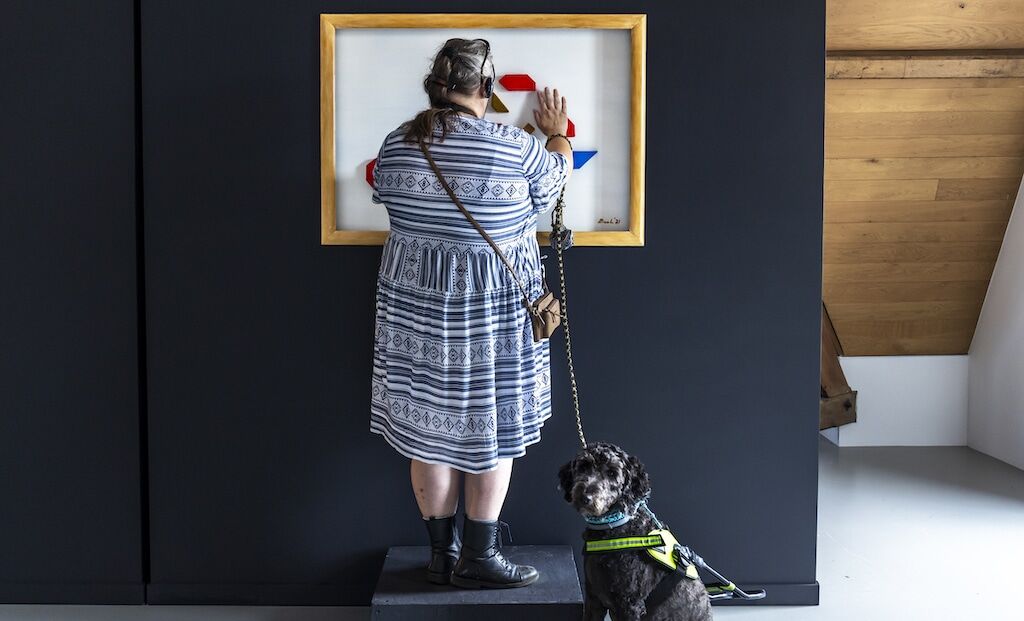A blind visitor touches artwork at The Blind Spot exhibition at Centraal Museum, Utrecht
Museums are places of constant inspiration. They can be a riot for all senses and an experience that can stay with visitors forever. However, if one can’t enter the buildings, speak the language or hear the exhibitions, then they quite quickly become a place of exclusivity and inaccessibility to some.
The Delinking and Relinking exhibit at the Van Abbemuseum in Eindhoven is a masterclass in designing a collection that puts accessibility for people with disabilities at its very core. In a recent presentation for MuseumNext, Marleen Hartjes and colleagues from the Van Abbemuseum discussed ways to create multi-sensory experiences for disabled audiences and highlight just what museums can learn from visitors with disabilities.
Inclusivity
By working collaboratively with audiences with disabilities the Van Abbemuseum first developed a range of special programmes and tours to support visitors with different disabilities back in 2014. These consisted of multi-sensory tours for blind and partially sighted visitors, tours in sign language by deaf tour guides, outspoken tours for visitors with aphasia, and unforgettable tours for people with dementia and their loved ones. There were also special opening hours and sensory-friendly museum visits for people with autism, acquired brain injury and burnouts.
There was something missing in this method and in the next phase, the museum moved to create a more programme-led approach that resulted in broader changes to internal processes at the museum for those with disabilities.
Multi-sensory experiences
The learnings from across the team led to a range of new ideas. For example, it was understood that blind visitors needed to understand an artwork and have an aesthetic experience using their hands. This led to a change in the museum vocabulary from an eyes-only space to spaces that acknowledge the body as a whole. Museums are, after all, a place to enjoy a sensory experience and this inspired a new research project – the multisensory museum – to see just what a museum designed for all senses could look like.
One of the outcomes of this research was the TIK-TIK app: an indoor navigation for blind visitors that turns your phone into a dowsing rod and leads you with intuitive feedback through the museum to describe artworks. The dream of the museum is to become inclusive enough that it caters for everyone.
Part of achieving this goal involves exhibitions and collections where accessibility is not just integrated, but is part of the concept of the exhibition itself – just like the Delinking and Relinking exhibition currently running at the museum. In this exhibition, every room has touch objects, touch drawings, fragrances and audio of musical compositions that were specifically made for the artworks.
Smartify
Smartify has also been employed to allow the museum to create a multi-layered yet intuitive experience for visitors. The Smartify app allows greater engagement with the artworks without being overly prescriptive in terms of the user experience. There are five different audio tours on Smartify of the Van Abbemuseum, which supports the numerous different layers to every story, presented in multiple languages.
The easy-to-use dashboard permits full control of the content creation process by the museum. This includes the ability to add new tours, link collection items, incorporate extra stops and add languages. With the use of the Smartify app amplifying the visitor experience, it is giving visitors more perspectives, more to do, more to learn and more reasons to come back.
To be relevant for the future, museums must become more inclusive though learning from the perspectives and expertise of all audiences. If a museum can become a richer, more welcoming place for a bigger variety of people, it can better connect with the wider community it serves.
Source: Creating multi-sensory experiences for disabled audiences at the Van Abbemuseum













